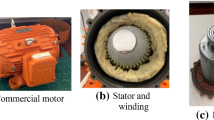Abstract
This paper presents an optimal design method to optimize cost of three-phase submersible motors. The optimally designed motor is compared with an industrial motor having the same ratings. The motor design procedure consists of a system of non-linear equations, which imposes induction motor characteristics, motor performance, magnetic stresses, and thermal limits. The genetic algorithm (GA) is used for cost optimization, and a software algorithm has been developed. As a result of the realized optimization, besides the improvements on the motor cost, motor torque improvements have also been acquired. The 2-D finite element method (FEM) is then used to confirm the validity of the optimal design. Computer simulation results are given to show the effectiveness of the proposed design process that can achieve a good prediction of the motor performance. Through the studies accomplished, it has been observed that submersible induction motors’ torques and efficiencies improve, their length reduces, and hence some material savings are obtained.
Similar content being viewed by others
Abbreviations
- ACT:
-
Weighted average coil throw
- A1m, Ab :
-
Cross-sectional area of stator and rotor conductor, respectively
- Ar, Ag :
-
Cross-sectional area of end-ring and air-gap, respectively
- Cucost :
-
Cost of unit weight of copper
- Cx :
-
Distribution factor
- CSK :
-
Skewing constant
- De :
-
Stator diameter at centers of stator slots
- Do :
-
Stator outer diameter
- Dr :
-
Rotor diameter
- Fecost :
-
Cost of unit weight of iron
- few :
-
End winding factor
- g:
-
Air gap
- Ib :
-
Rotor bar current
- Kp1 :
-
Stator flux factor
- Kwm :
-
Winding factor
- Kzz :
-
Zig-zag leakage reactance constant
- K1, K2 :
-
Carter coefficients
- L1, L2 :
-
Axial length of stator and rotor, respectively
- Pfe :
-
Density of the iron sheet
- Psw, Prw :
-
Density of stator and rotor conductors, respectively
- Pℓcu :
-
Total copper losses of stator and rotor
- Pℓfe :
-
Total iron losses
- qm :
-
Number of parallel paths in stator winding
- rew :
-
Average length of end-winding
- SF:
-
Stacking factor
- St :
-
Saturation factor
- S1, S2 :
-
Number of stator and rotor slot, respectively
- wa, wr,:
-
Rotor end rings axial and radial width, respectively
- ρm, ρb, ρr :
-
Resistivity of stator winding and rotor bar and end-ring, respectively
References
Üler GF, Mohammed OA, Koh CS (1994) Utilizing genetic algorithms for the optimal design of electromagnetic devices. IEEE Trans Magnet 30(6):4296–4298
Bianchi N, Bolognani S (1998) Design optimization of electric motors by genetic algorithm. IEE Proc Elec Power Appl 145:475–483
Wieczorek JP, Göl Ö, Michalewicz Z (1998) An evolutionary algorithm for the optimal design of induction motors. IEEE Trans Magnet 34(6):3882–3887
Hamarat S, Leblebicioğlu K, Ertan HB (1998) Comparison of deterministic and non-deterministic optimization algorithms for design optimization of electrical machines. ICEM, Istanbul, Turkey, pp 1477–1482
Çunkaş M, Akkaya R (2004) Design optimization of three-phase induction motors by using genetic algorithms. International Aegean Conference on Electrical Machines and Power Electronics, Istanbul, Turkey, pp 408–413
Bianchi N, Bolognani S, Comelato G (1999) Finite element analysis of three phase induction motors: comparison of two different approaches. IEEE Trans Energy Convers 14:1523–1528
De Weerdt HR, Tuinman E (1997) Finite element analysis of steady state behavior of squirrel cage induction motors compared with measurements. IEEE Trans Magnet 33:2093–2096
Çunkaş M (2004) Design optimization of electric motors by using genetic algorithms. Dissertation, Selçuk University, Konya, Turkey
Goldberg DE (1989) Genetic algorithms in search, optimisation, and machine learning. Addison-Wesley, Boston
Michalewicz Z (1994) Genetic algorithms + Data structures = Evolution programs, 2nd edn. Springer, Berlin Heidelberg New York
Haupt RL, Haupt SE (1998) Practical genetic algorithms. Willey Interscience, New York
Alger PL (1965) The nature of induction motor. Gordon and Breach, New York
Veinott CG (1959) Theory and design of small induction motors. McGraw-Hill, New York
Chapman SJ (2002) Electric machinery and power system fundamentals. McGraw-Hill, New York
Holland JH (1970). Robust algorithms for adaptation set in a general formal framework. In: Proc IEEE Symposium on Adaptive Processes, in Decision and Control, XVII, Section 5.1
Faiz J, Sharifian MBB, Keyhani A, Proca A (2000) Performance comparison of optimally designed induction motors with aluminum and copper squirrel-cages. Electr Mach Power Syst, Taylor & Francis 28:1195–1207
Author information
Authors and Affiliations
Corresponding author
Rights and permissions
About this article
Cite this article
Çunkaş, M., Akkaya, R. & Bilgin, O. Cost optimization of submersible motors using a genetic algorithm and a finite element method. Int J Adv Manuf Technol 33, 223–232 (2007). https://doi.org/10.1007/s00170-006-0458-x
Received:
Accepted:
Published:
Issue Date:
DOI: https://doi.org/10.1007/s00170-006-0458-x




